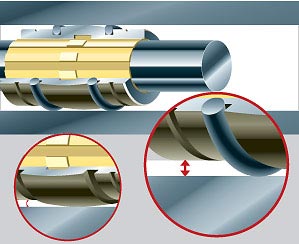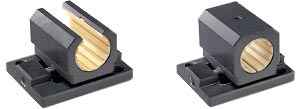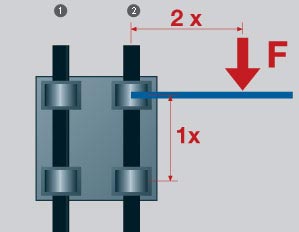For the successful use of maintenance-free DryLin® linear bearings, it is necessary to follow certain recommendations: If the distance between the driving force and the fixed bearing is more than double the bearing clearance (2:1 rule), a static coefficient of friction of 0.25 can theoretically result in the seizure of the guide.
This principle applies regardless of the load or drive force. It is a product of friction and is always related to the fixed bearing. The greater the distance between the drive and the guide bearing, the higher the degree of wear and required drive force.
Failure to observe the 2:1 rule during the use of linear slide bearings can result in uneven motion or even system blockage. Such situations can often be remedied with relatively simple modifications.
If you have any questions on design and/or assembly, please make use of our applications consultancy.
DryLin® R - Design tips
DryLin® linear plain bearings of the type series 03 offer great advantages in applications with parallel shafts. They compensate for alignment and parallelism errors by their special geometry and should be used on the shaft farthest from the drive.
The design provides a spherical area on the outer jacket of the aluminum bearings for self-alignment. Reductions in load capacity are prevented as the shaft always lies on the total projected surface. By the even load distribution over the entire bearing, edge loads do not occur with the self-aligning DryLin®- linear bearings. In order to compensate for parallelism errors between two shafts, the outer diameter is designed smaller than the housing bore diameter by (according to size) 0.2 to 0.3 mm. These bearings acquire an elastic seating by the use of the O-rings. The excess give the maximum permitted deviation from the parallelism.
The self-aligning bearings in the DryLin® product range are supplied hard anodized. These surfaces guarantee the highest wear resistance if the aluminum bearing moves in the housing during compensation adjustments.
Another option are the housing bearings of the type series OJUM06 LL and RJUM-06 LL. The mounting of the bearing allows a parallelism adjustment between the shafts by ±3 mm. The unique suspension of the supporting housing on an axis running in the z-direction enables an angular error compensation of up to 3.5°.

Fig. 04: By defined installation clearance and externally mounted O-rings, the self-aligning DryLin® R bearings of the type series 03 can compensate parallelism errors. The spherical drylin® adapter can compensate for parallelism errors. A hard-anodization protects the aluminum adapter from wear

Left: OJUM-06 LL, Right: RJUM-06 LL
| Series RJUM-03 / OJUM-03 | +/- 0,5° |
| Series RJUM-06 LL / OJUM-06 LL | +/- 3,5° |
| Series RJUM-03 / OJUM-03 | +/- 0,1 mm |
| Series RJUM-06 LL / OJUM-06 LL | +/- 3 mm |

Fig. 03: The 2:1 rule,
1. Floating bearing, 2. Fixed bearing
More than 100,000 products available! Delivery and consultation Mon-Fri from 7am-8pm and Sat from 8am-12pm!